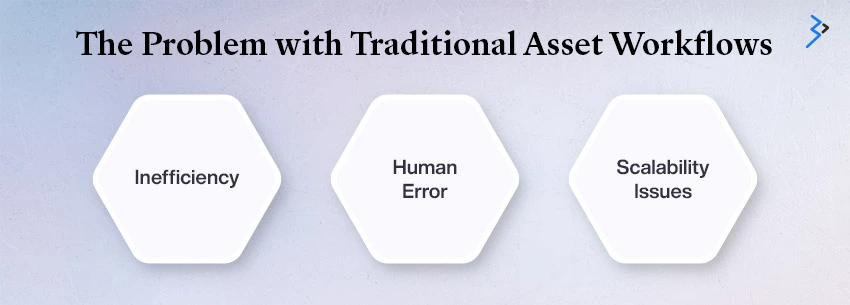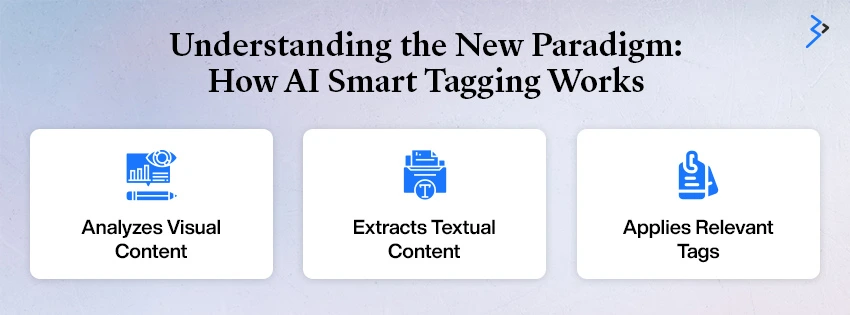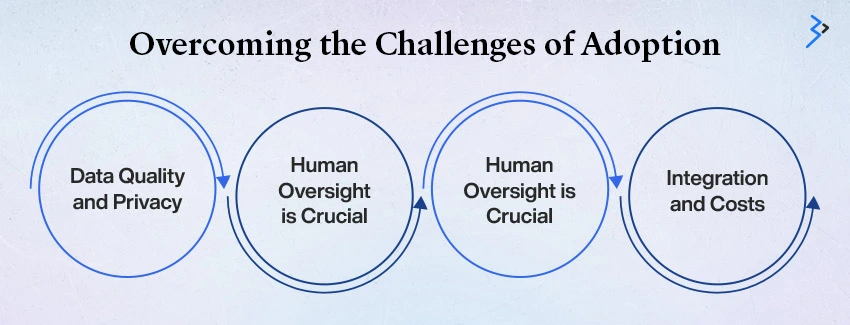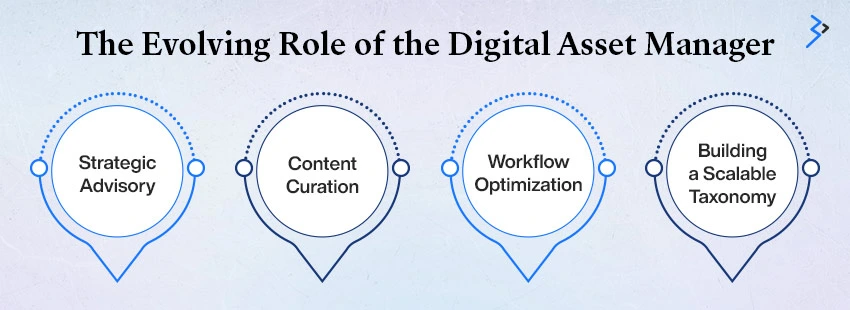Imagine an extensive digital library without an easy way to find files. It’s full of images and documents, making it hard, for example, to locate a photo of a “team celebrating a product launch.” For years, employees spent a lot of time manually tagging assets, which was often inconsistent.
A 2021 survey by Canto found that many marketing professionals waste about three weeks a year searching for files. Poor tagging leads to “dark assets” that are difficult to find, wasting time and resources.
Now, AI-driven smart tagging is changing the game. Instead of relying on manual tagging, intelligent systems can quickly and accurately label assets. This shift allows teams to focus on creating great content rather than searching for files. A blog post explores how AI smart tagging transforms asset management and provides significant value to businesses.
The Problem with Traditional Asset Workflows

Due to slow and manual processes, the marketing industry faces challenges in managing digital assets. Here are the three main issues:
1. Inefficiency: Tagging digital assets with metadata can take time. For instance, it could take a team of ten over a month to tag two million items, delaying the workflow and response to market trends.
2. Human Error: Different people may use varying terms for the same asset, making it hard to locate them later. This inconsistency can lead to “dark assets,” often recreated unnecessarily.

3. Scalability Issues: As organizations grow, the volume of digital content increases, making manual tagging unsustainable. The Digital Asset Management market is expected to grow significantly, from $4.7 billion in 2023 to $20.3 billion by the decade’s end, highlighting the rising need for efficient solutions.
Understanding the New Paradigm: How AI Smart Tagging Works

AI-driven smart tagging is a transformative force because it moves beyond simple automation. While traditional tools are great at repetitive, rule-based tasks, they can’t understand the content. Generative AI uses powerful machine learning models, like computer vision and natural language processing (NLP), to “see” and “understand” content at a deeper level. Adobe Sensei powers this intelligence in Adobe Experience Manager (AEM) Assets.
Let us take a closer look at it:
- Analyzes Visual Content: For images and videos, Adobe Sensei scans the content to identify objects, scenes, actions, and emotions. For example, it can recognize that a photo contains “a man,” “a woman,” and a “dog.”
- Extracts Textual Content: For documents and PDFs, AI can read and understand the keywords and entities within the text, summarizing its main points.
- Applies Relevant Tags: The AI automatically applies descriptive keywords or “tags” to the asset’s metadata based on its analysis. These tags are often assigned a “confidence score,” which indicates how specific the AI is about its prediction, making it a key feature of AI machine learning services.
The result is a system that automates the most time-consuming part of asset management while delivering highly accurate and consistent metadata. Allowing marketing teams to transition from manual, time-consuming reviews to more brilliant, faster workflows.
The Unlocking Power: Key Benefits of AI-Driven Tagging

The real magic of AI smart tagging lies in its ability to address the fundamental issues of traditional DAM (Digital Asset Management). Automating the grunt work unlocks powerful new capabilities and efficiencies across your entire content lifecycle.
Enhanced Searchability and Discoverability. With automated, consistent tags, your assets become instantly searchable. Users no longer need to remember the keyword used by the person who uploaded the asset. Instead, they can use natural language to find what they need. Imagine a creative director typing “images of people hiking in the forest,” and the system instantly pulling up every relevant photo. This intelligent search capability saves countless hours weekly and ensures that no asset is ever truly “lost.”
Unprecedented Speed and Efficiency: Smart tagging significantly reduces the time it takes for new assets to become usable. As soon as an asset is uploaded, the AI tags it automatically, making it available for search and use almost instantly. A survey by Synthesia found that AI-powered tools can improve an individual’s productivity by up to 40% by saving time on repetitive tasks, which directly applies to asset management workflows.
Metadata Consistency and Governance: AI-powered tagging eliminates human error and ensures a consistent metadata schema. The algorithm is the same for every asset, so its tags are uniform. This consistency is crucial for a clean DAM system. In AEM, you can train the AI on your specific business taxonomy and brand guidelines, ensuring the tags align with your company’s internal vocabulary. You can also create “blocklists” to prevent certain words from being applied as tags, ensuring brand compliance.
Scalability and Future-Proofing: As your company’s digital content grows, an AI-powered system scales effortlessly. It can process a thousand assets as easily as a million. Ensuring that your DAM system remains a valuable, efficient tool is crucial, regardless of the content volume you manage. It also future-proofs your organization for the coming wave of content creation, driven by generative AI development services.
AI-Driven Tagging in Action: Practical Use Cases

The benefits of AI-driven smart tagging are delivering real, measurable value across various industries.
According to a case study by Henry Stewart Publications, Paramount Pictures’ Stills Archive team improved its DAM system by integrating an AI-based metadata service. The upgrade streamlined workflows, reduced research time, and enhanced management of their vast photography and artwork archive.
A McKinsey research report suggests that AI can help capture 25 to 40 percent of the total cost base in organizational efficiencies.
- Retail and eCommerce: AI can automatically tag millions of product images with details like “product type,” “color,” and “season.” Pulling all images for a new “fall collection” is streamlined and efficient, allowing quicker access. As a result, customers benefit from more accurate search results, enhancing their overall experience.
- Media and Entertainment: AI can be a game-changer for a media company with vast video footage archives. It can not only tag entire videos but also create tags for specific moments or scenes within the video. For example, it can recognize and tag a scene as “sports event” or “goal celebration,” making it easy for editors to find and use specific clips.
- Financial Services: In the highly regulated finance industry, AI ensures that all marketing assets are tagged correctly with disclaimers and usage rights. It can even flag a photo to prevent it from being misused by a competitor.
- Manufacturing: AI can automate tagging technical diagrams, product schematics, and instructional videos. Engineers need to easily access the documents they require for maintenance and troubleshooting.
Overcoming the Challenges of Adoption

While AI smart tagging has excellent potential, its implementation poses challenges that organizations must address for success.
Data Quality and Privacy: AI effectiveness relies on the quality of training data. Poor or inconsistent data leads to inaccurate tags, and since legal and business documents often contain sensitive information, using a secure and organized dataset is essential.
Understanding AI Decisions: Some AI models don’t explain their reasoning, which can be problematic in legal and business contexts. Organizations should select AI solutions that clearly demonstrate how tags are assigned.
Human Oversight is Crucial: AI will enhance, not replace, Digital Asset Management (DAM) professionals. Automating repetitive tasks allows them to focus on strategic work, but human oversight remains vital to ensure accuracy.
Integration and Costs: Setting up an AI system can be complex and costly. The new system should integrate smoothly with existing tools, and organizations should have a clear plan for implementation and team training.
Read More – Why Choose Adobe Digital Asset Management for Your Business
The Evolving Role of the Digital Asset Manager

The shift isn’t just about adopting a new technology; it’s about reshaping the role of the digital asset manager. With AI handling the heavy lifting of tagging and organization, professionals are moving beyond being mere archivists to becoming strategic content managers. With AI handling the routine, the human team can focus on what truly matters:
- Strategic Advisory: Providing high-level counsel to marketing and creative teams on utilizing and organizing assets to meet business goals.
- Content Curation: Leveraging human expertise to select the best assets for specific campaigns and ensuring the content aligns with the brand’s voice and vision.
- Workflow Optimization: Designing and implementing streamlined workflows that maximize the value of both human and AI-driven processes.
- Building a Scalable Taxonomy: Continuously refining the company’s tagging and metadata structure to ensure it remains relevant and valuable as the business evolves.
Conclusion: Partnering for a Smarter Future
The future of digital asset management is here, driven by AI. Smart tagging and automated metadata make managing, finding, and using digital content easier and faster, reducing risks and improving efficiency. This technology acts as a helpful assistant, allowing marketing professionals to focus on more meaningful tasks.
At Brainvire, we acknowledge that every organization encounters its challenges. We collaborate with you to create a strategic plan for implementing AI solutions that align with your specific needs, prioritizing data security and seamless integration. Our partnership aims to convert sluggish processes into a competitive edge for your business.
FAQs:-
AI-driven smart tagging uses machine learning models like computer vision and natural language processing to analyze images, videos, and documents. In Adobe Experience Manager (AEM) Assets, Adobe Sensei automatically applies accurate metadata and tags, making assets easier to search, discover, and use.
Unlike manual tagging, which is time-consuming and error-prone, AI ensures speed, consistency, and scalability. It can instantly process thousands of assets, apply uniform tags, and eliminate issues like “dark assets” that often get lost in a manual system.
Yes. Adobe Sensei in AEM allows businesses to train AI on their own taxonomy, industry-specific terminology, and brand guidelines. You can even set blocklists to prevent unwanted tags, ensuring the system aligns perfectly with your organization’s vocabulary and compliance needs.
The main benefits include faster content discovery, improved team productivity, reduced costs, and better brand compliance. For example, marketing teams spend less time searching for assets and more time creating campaigns, while IT ensures scalability as digital content libraries grow.
The biggest challenges include ensuring high-quality training data, maintaining data privacy, understanding AI decision-making, and managing integration costs. While AI automates repetitive tasks, human oversight remains crucial to validate tags and optimize workflows.
Related Articles
-
Streamlining Digital Asset Management with AEM Assets
Summary With 89% of marketers crediting personalization in their campaigns for positive ROI, it has become the key to success for many growing businesses. This is where organizations today are
-
Elevate your Adobe Experience Manager Sites Website with Generative AI Chatbots
Thanks to today’s fast-paced digital landscape, customers have higher expectations than ever before. Users now demand immediate access to information, be it for sales inquiries, customer service issues, or general
-
How does Adobe Real-Time CDP Empower Personalization at Scale?
Summary Did you know? A customer interacts with brands at more than six touchpoints across different channels! Yes, it’s true! Throughout their journey, customers expect a seamless and personalized experience




